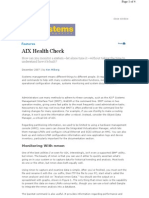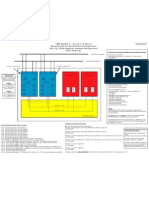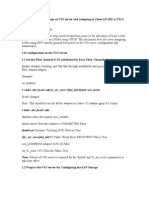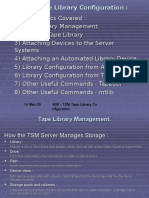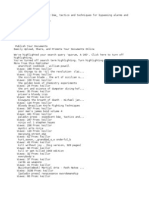Zoning With SAN Switch
Zoning With SAN Switch
Uploaded by
Kapil BhuskuteCopyright:
Available Formats
Zoning With SAN Switch
Zoning With SAN Switch
Uploaded by
Kapil BhuskuteCopyright
Available Formats
Share this document
Did you find this document useful?
Is this content inappropriate?
Copyright:
Available Formats
Zoning With SAN Switch
Zoning With SAN Switch
Uploaded by
Kapil BhuskuteCopyright:
Available Formats
Description
SAN Switch Zoning
Platform
SAN switch
Model
Brocade SAN switch
Category
Trouble shooting and Tips
Problem statement
SAN switch zoning and implementation
Solution
Zoning the SAN
What is zoning?
Zoning is a mechanism for controlled segmentation of a Fibre Channel fabric. Zoning introduces a degree of flexibility into a fabric to meet the needs of the user group objectives Zoning can be used as a security feature.
Types of zoning Hard zoning is defined as "a zone that is enforced by the fabric, often as a hardware function. The fabric will forward frames among zone members within a hard zone. However, the fabric prohibits frames from being forwarded to members not within a hard zone. Typically, switch ports define a hard zone. Soft zoning "consists of zone members who are made visible to each other through client service requests. Typically, soft zones contain zone members that are visible to devices via the name server exposure of zone members. The fabric does not enforce a soft zone." WWN define soft zone.
Why implement zoning? Adds the ability to partition the SAN into logical groupings of devices. Simplifies a heterogeneous environment within the same switched fabric. Implements information access security. Can enhance performance.
What can happen without zoning? Data corruption and loss Performance impacts Devices not able to connect to the proper resources
Zoning the SAN Depending on the method of port designation within a zone, the enforcement of zoning restrictions can be implemented at various points. Zone enforcement is referred to as either hard zoning (switch port number) or soft zoning (using WWN). A device or port can be in multiple zones Hard zoning prevents access by unauthorized members, typically implemented within switch hardware. The primary method is to define a set of switch ports into a zone. Hard zoning usually allows for node and/or node port replacement without the need for zone changes Soft zoning is a restriction of information to the requesting node port from the domain name server, and is also based on the assumption that a device's node port is well-behaved. Soft zoning would use WWN, where the connection to the device can be moved within the fabric from port to port.
Zone configurations can be defined with a mix of both hard and soft zoning, but normally not suggested.
Zoning the SAN Best Practices Zone devices with similar operating systems together, such as a zone for Windows 2000, another for AIX, etc. Zone devices with HBAs by the same manufacturer together. For example, Windows servers with a mixture of HBAs by Emulex and QLogic would be in 2 zones. Use numerous, smaller zone sets in a configuration instead of fewer, large zone sets. Individual zones for specific applications by server and storage resource(s) Individual zones for servers in a cluster and their storage resource(s)
IMPLEMENTING ZONING # alicreate alias, WWN # alicreate alias, WWN # zonecreate zonename, HBA_alias; storageport_alias # cfgadd Config_name, zone_name # cfgsave # cfgenable Config_name ==================================================== == * To get cfg_name # switchshow | more * zoning = ON ( cfg_name) * To get zone_name # zoneshow alias_name * make sure with both server_hba & storage_port aliases ==================================================== ===
You might also like
- NSX-T Data Center 3.2.3 Configuration - MaximumsDocument19 pagesNSX-T Data Center 3.2.3 Configuration - Maximumssupriono legimin100% (1)
- Cableiq Reporter: Getting Started GuideDocument14 pagesCableiq Reporter: Getting Started GuidedisklbbNo ratings yet
- AIX Health CheckDocument4 pagesAIX Health CheckAashish Bhaisare100% (1)
- BCP DRDocument61 pagesBCP DRTapas Bhattacharya100% (1)
- DRBD-Cookbook: How to create your own cluster solution, without SAN or NAS!From EverandDRBD-Cookbook: How to create your own cluster solution, without SAN or NAS!No ratings yet
- VxRail Appliance - VxRail How To Change Vmotion NetworkDocument7 pagesVxRail Appliance - VxRail How To Change Vmotion Networkarthur jhonatan barzola mayorgaNo ratings yet
- Brocade ZoningDocument3 pagesBrocade Zoninghema_rao2250No ratings yet
- Create Zone On The SAN SwitchDocument3 pagesCreate Zone On The SAN Switchसंतोष शर्माNo ratings yet
- 0002 V7000 VMware Storage PracticesDocument34 pages0002 V7000 VMware Storage PracticesJose RuizNo ratings yet
- Ccna NotesDocument49 pagesCcna Notesyaya konateNo ratings yet
- NSX Logical Switching and DLRDocument16 pagesNSX Logical Switching and DLRsivakumarNo ratings yet
- RDM in VMwareDocument3 pagesRDM in VMwaresreegyadav1No ratings yet
- NSX For Vsphere Getting Started GuideDocument43 pagesNSX For Vsphere Getting Started GuideAlexander FerreiraNo ratings yet
- VMA02 iSCSI For AIX and VIO Leibl AndreasDocument35 pagesVMA02 iSCSI For AIX and VIO Leibl Andreasthatseasy123No ratings yet
- Aix 6 Security June 19Document38 pagesAix 6 Security June 19vishalNo ratings yet
- Dcufiv4 Lab PDFDocument224 pagesDcufiv4 Lab PDFjustoalonsogarciaNo ratings yet
- Zoning Configuration StepDocument9 pagesZoning Configuration StepPurushothama GnNo ratings yet
- VMware Migration PlanDocument10 pagesVMware Migration PlanckwambuaNo ratings yet
- AVD-SD Branch Midsize Design DeployDocument153 pagesAVD-SD Branch Midsize Design DeployMisa AmaneNo ratings yet
- Designing A PowerHA SystemMirror For AIX High Availability Solution - HA17 - HerreraDocument59 pagesDesigning A PowerHA SystemMirror For AIX High Availability Solution - HA17 - HerreraFabrice PLATELNo ratings yet
- Cisco Switch Zoning - Quick ReferenceDocument4 pagesCisco Switch Zoning - Quick ReferenceArunKumarNo ratings yet
- Cisco Mds 9222 UpgradeDocument8 pagesCisco Mds 9222 UpgradetelagamsettiNo ratings yet
- Cisco - UCS (Unified Computing Systems)Document33 pagesCisco - UCS (Unified Computing Systems)Sheldon NailerNo ratings yet
- Upgrade ESXi 6.7 To 7 and 7.0 U2 (Multiple Methods)Document17 pagesUpgrade ESXi 6.7 To 7 and 7.0 U2 (Multiple Methods)sreegyadav1No ratings yet
- Connectrix - Brocade Departmental Firmware Upgrade Procedures-DS-6510BDocument19 pagesConnectrix - Brocade Departmental Firmware Upgrade Procedures-DS-6510BSantosh SharmaNo ratings yet
- IBM V7000 SAN Storage: Thin Provisioned vs. Fully AllocatedDocument70 pagesIBM V7000 SAN Storage: Thin Provisioned vs. Fully Allocatedjack_garcia-7ox3sfccNo ratings yet
- Initial ISCSI Setup of The VSphere 4 ServerDocument3 pagesInitial ISCSI Setup of The VSphere 4 ServerMurali019No ratings yet
- NutanixDocument43 pagesNutanixkailash.mcseNo ratings yet
- AN102G2LSGDocument24 pagesAN102G2LSGCatalin SerbanescuNo ratings yet
- VIOS Physical & Virtual Ethernet CFG For 802.1qDocument1 pageVIOS Physical & Virtual Ethernet CFG For 802.1qVasanth VuyyuruNo ratings yet
- IBM Security Qradar DSM Configuration Guide AddendumDocument194 pagesIBM Security Qradar DSM Configuration Guide AddendumTaaaanNo ratings yet
- Aix 6 CronDocument18 pagesAix 6 CronmostpleasingNo ratings yet
- How To Configure VIO LUNs From SAN To Client LPARsDocument9 pagesHow To Configure VIO LUNs From SAN To Client LPARsTirumala RaoNo ratings yet
- IBM AIX Commands You Should Not Leave Home WithoutDocument36 pagesIBM AIX Commands You Should Not Leave Home Withoutprakash_6849No ratings yet
- Brocade Zoning StepsDocument2 pagesBrocade Zoning StepsAshish VermaNo ratings yet
- Reference Architecture: 11 April 2019 Vrealize Automation 7.6Document41 pagesReference Architecture: 11 April 2019 Vrealize Automation 7.6Mahender Singh Yadav100% (1)
- Vmware Solutions: Technical PerspectiveDocument28 pagesVmware Solutions: Technical PerspectivePritesh WaghelaNo ratings yet
- IBM PowerVM Disk-Tape VirtualizationDocument23 pagesIBM PowerVM Disk-Tape VirtualizationliuylNo ratings yet
- ENCOR Jul14Document389 pagesENCOR Jul14Ronald SinghNo ratings yet
- Pve Admin Guide 8.1Document593 pagesPve Admin Guide 8.1kingofpc20No ratings yet
- Vmware Vsphere: Troubleshooting Workshop: Lab Manual Esxi 5.5 and Vcenter Server 5.5Document161 pagesVmware Vsphere: Troubleshooting Workshop: Lab Manual Esxi 5.5 and Vcenter Server 5.5StevenNo ratings yet
- BCO1505-VMware Vsphere Replication Technical Walk-Through With Engineering - Final - US PDFDocument35 pagesBCO1505-VMware Vsphere Replication Technical Walk-Through With Engineering - Final - US PDFkinan_kazuki104100% (1)
- VxRail Appliance - VxRail Software Upgrade Procedures-VxRail E560 - E560FDocument27 pagesVxRail Appliance - VxRail Software Upgrade Procedures-VxRail E560 - E560FNicholas LeeNo ratings yet
- IBM Tape Library ConfigurationDocument13 pagesIBM Tape Library ConfigurationSatya CharanNo ratings yet
- 9.2.2.7 Lab - Certificate Authority Stores PDFDocument9 pages9.2.2.7 Lab - Certificate Authority Stores PDFInteresting facts Channel0% (1)
- Nim Upgrade and Advanced TopicsDocument49 pagesNim Upgrade and Advanced TopicsPrabu KrishnanNo ratings yet
- VMware Notes OthersDocument65 pagesVMware Notes Otherssreegyadav1No ratings yet
- Setting Up A User Exit On DB2 UDB V8 To Archive Database LogsDocument9 pagesSetting Up A User Exit On DB2 UDB V8 To Archive Database LogsManohar ViswanathaNo ratings yet
- Vsphere Distributed Switch Best PracticesDocument30 pagesVsphere Distributed Switch Best PracticesnewbeoneNo ratings yet
- Nimble Best Practices For VMwareDocument15 pagesNimble Best Practices For VMwarepry_kumNo ratings yet
- PD032 - InstallGuide - Site Recovery Manager - 8.2.xDocument111 pagesPD032 - InstallGuide - Site Recovery Manager - 8.2.xrahul koulNo ratings yet
- Veeam Backup and Replication Operations Guide - Volume 3Document531 pagesVeeam Backup and Replication Operations Guide - Volume 3karam horaneNo ratings yet
- How To Patch ESXi 7 Using Lifecycle Manager - Mastering VMwareDocument8 pagesHow To Patch ESXi 7 Using Lifecycle Manager - Mastering VMwareVinoth KumarNo ratings yet
- VSICM55 M12 PatchManagement PDFDocument32 pagesVSICM55 M12 PatchManagement PDFandyNo ratings yet
- NSX 64 AdminDocument456 pagesNSX 64 AdminBarnabás JanovszkiNo ratings yet
- ESX CommandsDocument60 pagesESX Commandssd_choudhury2No ratings yet
- BCO2382-VMware Vsphere HA Recommendations To Maximize Virtual Machine Uptime - Final - US PDFDocument75 pagesBCO2382-VMware Vsphere HA Recommendations To Maximize Virtual Machine Uptime - Final - US PDFkinan_kazuki104No ratings yet
- VPC Configuration Best PracticesDocument113 pagesVPC Configuration Best Practicesyassine100% (1)
- How To Install Openshift On A Laptop or DesktopDocument7 pagesHow To Install Openshift On A Laptop or DesktopAymen100% (1)
- Red Hat Enterprise Linux 9 Administration: A comprehensive Linux system administration guide for RHCSA certification exam candidatesFrom EverandRed Hat Enterprise Linux 9 Administration: A comprehensive Linux system administration guide for RHCSA certification exam candidatesNo ratings yet
- Recommender Systems An Introduction 1st Edition Dietmar Jannach Download PDFDocument84 pagesRecommender Systems An Introduction 1st Edition Dietmar Jannach Download PDFnasiffaladwy100% (2)
- Mit Rivastava: Career SummaryDocument8 pagesMit Rivastava: Career SummaryNarendra BodkheNo ratings yet
- What Is Exploratory Data Analysis (EDA)Document13 pagesWhat Is Exploratory Data Analysis (EDA)emansyed2212100% (1)
- Salesforce App LimitsDocument19 pagesSalesforce App LimitsJuan Carlos Nava SanchezNo ratings yet
- Interview Questions On Material UIDocument4 pagesInterview Questions On Material UIMadiha SyedNo ratings yet
- Learning Proxmox VE - Sample ChapterDocument47 pagesLearning Proxmox VE - Sample ChapterPackt Publishing100% (1)
- CO Line Item Reports: Creating A User-Defined FieldDocument6 pagesCO Line Item Reports: Creating A User-Defined FieldpyericNo ratings yet
- SOLID WORKS-Tutorial 22Document13 pagesSOLID WORKS-Tutorial 22FREDYTOAPANTANo ratings yet
- Controller Area Network (CAN) Information, Working and AdvantagesDocument5 pagesController Area Network (CAN) Information, Working and AdvantagesAbhijeet KeshriNo ratings yet
- Ksu Resume Assignment2Document3 pagesKsu Resume Assignment2api-242671665No ratings yet
- Ai Tools PDFDocument273 pagesAi Tools PDFaiwiki001No ratings yet
- Building A Simple Web ServerDocument6 pagesBuilding A Simple Web ServerAnh WeasleyNo ratings yet
- Text 1 What Is Information TechnologyDocument30 pagesText 1 What Is Information TechnologyCaraiman GeorgeNo ratings yet
- What Is A ProductDocument2 pagesWhat Is A ProductAli Md. Hasan 2025144660No ratings yet
- Calling RFC Function Modules in ABAPDocument81 pagesCalling RFC Function Modules in ABAPPedro NunesNo ratings yet
- Assigment 01 Html5 Game v0.4 PDFDocument25 pagesAssigment 01 Html5 Game v0.4 PDFgotohellNo ratings yet
- Paladin Press - Expedient B&e - Tactics and Techniques For Bypassing Alarms and Defeating Locks (HDocument6 pagesPaladin Press - Expedient B&e - Tactics and Techniques For Bypassing Alarms and Defeating Locks (Hanon-948045100% (3)
- Lecture 1Document25 pagesLecture 1Gursimar SinghNo ratings yet
- Inpqs Digitally Transforming Specification in The Construction IndustryDocument15 pagesInpqs Digitally Transforming Specification in The Construction IndustryAngie Siok Ting LimNo ratings yet
- Sri Vidya College of Engineering and Technology Question BankDocument5 pagesSri Vidya College of Engineering and Technology Question BankThiyagarajan JayasankarNo ratings yet
- Berekening Controlecijfer MRN-GRN PDFDocument7 pagesBerekening Controlecijfer MRN-GRN PDFmladendjNo ratings yet
- Lesson Plan: Redesign Classroom FurnitureDocument19 pagesLesson Plan: Redesign Classroom FurnitureMariaNo ratings yet
- Ramya B.E JavaDeveloper 2018Document1 pageRamya B.E JavaDeveloper 2018Durgadevi BNo ratings yet
- Sqa Lectures RoutineDocument5 pagesSqa Lectures RoutineShaan KhalidNo ratings yet
- Comp 9Document3 pagesComp 9Soumya BishnuNo ratings yet
- List of SoftwaresDocument16 pagesList of SoftwaresOSCAR ENMANUEL BERMUDEZ AYERDISNo ratings yet
- Software Specification DocumentDocument19 pagesSoftware Specification Documentans_h2003No ratings yet
- Graphical User Interface: Menus, Pointer) System, Such As Microsoft Windows or The Apple MacDocument5 pagesGraphical User Interface: Menus, Pointer) System, Such As Microsoft Windows or The Apple MacAurel FransiscaNo ratings yet


